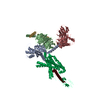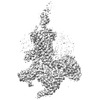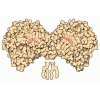[English] 日本語
 Yorodumi
Yorodumi- EMDB-26104: Cryo-EM structure of corticotropin releasing factor receptor 2 bo... -
+ Open data
Open data
- Basic information
Basic information
| Entry |  | ||||||||||||||||||
|---|---|---|---|---|---|---|---|---|---|---|---|---|---|---|---|---|---|---|---|
| Title | Cryo-EM structure of corticotropin releasing factor receptor 2 bound to Urocortin 1 and coupled with heterotrimeric Go protein | ||||||||||||||||||
 Map data Map data | |||||||||||||||||||
 Sample Sample |
| ||||||||||||||||||
| Function / homology |  Function and homology information Function and homology informationhistone deacetylase inhibitor activity / corticotrophin-releasing factor receptor activity / corticotropin-releasing hormone receptor 2 binding / positive regulation of corticotropin secretion / positive regulation of behavioral fear response / varicosity / negative regulation of hormone secretion / positive regulation of cAMP-mediated signaling / response to auditory stimulus / drinking behavior ...histone deacetylase inhibitor activity / corticotrophin-releasing factor receptor activity / corticotropin-releasing hormone receptor 2 binding / positive regulation of corticotropin secretion / positive regulation of behavioral fear response / varicosity / negative regulation of hormone secretion / positive regulation of cAMP-mediated signaling / response to auditory stimulus / drinking behavior / negative regulation of appetite / corticotropin-releasing hormone receptor 1 binding / neuropeptide hormone activity / positive regulation of vascular permeability / negative regulation of cell size / G-protein activation / Activation of the phototransduction cascade / Glucagon-type ligand receptors / Thromboxane signalling through TP receptor / Sensory perception of sweet, bitter, and umami (glutamate) taste / G beta:gamma signalling through PI3Kgamma / G beta:gamma signalling through CDC42 / Cooperation of PDCL (PhLP1) and TRiC/CCT in G-protein beta folding / Activation of G protein gated Potassium channels / Inhibition of voltage gated Ca2+ channels via Gbeta/gamma subunits / Ca2+ pathway / G alpha (z) signalling events / Vasopressin regulates renal water homeostasis via Aquaporins / G protein-coupled peptide receptor activity / Glucagon-like Peptide-1 (GLP1) regulates insulin secretion / Adrenaline,noradrenaline inhibits insulin secretion / ADP signalling through P2Y purinoceptor 12 / G alpha (q) signalling events / Class B/2 (Secretin family receptors) / Thrombin signalling through proteinase activated receptors (PARs) / G alpha (i) signalling events / alkylglycerophosphoethanolamine phosphodiesterase activity / photoreceptor outer segment membrane / spectrin binding / negative regulation of feeding behavior / response to pain / positive regulation of calcium ion import / startle response / associative learning / peptide hormone binding / social behavior / photoreceptor outer segment / neuropeptide signaling pathway / positive regulation of collagen biosynthetic process / Synthesis, secretion, and deacylation of Ghrelin / response to glucocorticoid / axon terminus / cardiac muscle cell apoptotic process / regulation of synaptic transmission, glutamatergic / positive regulation of cardiac muscle contraction / negative regulation of blood pressure / photoreceptor inner segment / aerobic respiration / positive regulation of DNA replication / positive regulation of translation / female pregnancy / long-term synaptic potentiation / sensory perception of sound / adenylate cyclase-modulating G protein-coupled receptor signaling pathway / positive regulation of interleukin-6 production / vasodilation / sensory perception of taste / neuron projection development / heterotrimeric G-protein complex / signaling receptor complex adaptor activity / positive regulation of peptidyl-serine phosphorylation / GTPase binding / response to estradiol / retina development in camera-type eye / phospholipase C-activating G protein-coupled receptor signaling pathway / positive regulation of cytosolic calcium ion concentration / cellular response to hypoxia / cell body / G alpha (s) signalling events / positive regulation of cell growth / perikaryon / negative regulation of neuron apoptotic process / response to oxidative stress / cell population proliferation / cell surface receptor signaling pathway / G protein-coupled receptor signaling pathway / negative regulation of gene expression / GTPase activity / dendrite / synapse / protein-containing complex binding / positive regulation of transcription by RNA polymerase II / extracellular region / plasma membrane / cytoplasm Similarity search - Function | ||||||||||||||||||
| Biological species |  Homo sapiens (human) / Homo sapiens (human) /  | ||||||||||||||||||
| Method | single particle reconstruction / cryo EM / Resolution: 2.8 Å | ||||||||||||||||||
 Authors Authors | Zhao L-H / Lin J / Mao C / Zhou XE / Ji S / Shen D / Xiao P / Melcher K / Zhang Y / Yu X / Xu HE | ||||||||||||||||||
| Funding support |  China, China,  United States, 5 items United States, 5 items
| ||||||||||||||||||
 Citation Citation |  Journal: Nat Commun / Year: 2022 Journal: Nat Commun / Year: 2022Title: Structure insights into selective coupling of G protein subtypes by a class B G protein-coupled receptor. Authors: Li-Hua Zhao / Jingyu Lin / Su-Yu Ji / X Edward Zhou / Chunyou Mao / Dan-Dan Shen / Xinheng He / Peng Xiao / Jinpeng Sun / Karsten Melcher / Yan Zhang / Xiao Yu / H Eric Xu /   Abstract: The ability to couple with multiple G protein subtypes, such as G, G, or G, by a given G protein-coupled receptor (GPCR) is critical for many physiological processes. Over the past few years, the ...The ability to couple with multiple G protein subtypes, such as G, G, or G, by a given G protein-coupled receptor (GPCR) is critical for many physiological processes. Over the past few years, the cryo-EM structures for all 15 members of the medically important class B GPCRs, all in complex with G protein, have been determined. However, no structure of class B GPCRs with G has been solved to date, limiting our understanding of the precise mechanisms of G protein coupling selectivity. Here we report the structures of corticotropin releasing factor receptor 2 (CRF2R) bound to Urocortin 1 (UCN1), coupled with different classes of heterotrimeric G proteins, G and G. We compare these structures with the structure of CRF2R in complex with G to uncover the structural differences that determine the selective coupling of G protein subtypes by CRF2R. These results provide important insights into the structural basis for the ability of CRF2R to couple with multiple G protein subtypes. | ||||||||||||||||||
| History |
|
- Structure visualization
Structure visualization
| Supplemental images |
|---|
- Downloads & links
Downloads & links
-EMDB archive
| Map data |  emd_26104.map.gz emd_26104.map.gz | 40.1 MB |  EMDB map data format EMDB map data format | |
|---|---|---|---|---|
| Header (meta data) |  emd-26104-v30.xml emd-26104-v30.xml emd-26104.xml emd-26104.xml | 17.5 KB 17.5 KB | Display Display |  EMDB header EMDB header |
| Images |  emd_26104.png emd_26104.png | 98.7 KB | ||
| Archive directory |  http://ftp.pdbj.org/pub/emdb/structures/EMD-26104 http://ftp.pdbj.org/pub/emdb/structures/EMD-26104 ftp://ftp.pdbj.org/pub/emdb/structures/EMD-26104 ftp://ftp.pdbj.org/pub/emdb/structures/EMD-26104 | HTTPS FTP |
-Related structure data
| Related structure data |  7ts0MC  7tryC C: citing same article ( M: atomic model generated by this map |
|---|---|
| Similar structure data | Similarity search - Function & homology  F&H Search F&H Search |
- Links
Links
| EMDB pages |  EMDB (EBI/PDBe) / EMDB (EBI/PDBe) /  EMDataResource EMDataResource |
|---|---|
| Related items in Molecule of the Month |
- Map
Map
| File |  Download / File: emd_26104.map.gz / Format: CCP4 / Size: 42.9 MB / Type: IMAGE STORED AS FLOATING POINT NUMBER (4 BYTES) Download / File: emd_26104.map.gz / Format: CCP4 / Size: 42.9 MB / Type: IMAGE STORED AS FLOATING POINT NUMBER (4 BYTES) | ||||||||||||||||||||||||||||||||||||
|---|---|---|---|---|---|---|---|---|---|---|---|---|---|---|---|---|---|---|---|---|---|---|---|---|---|---|---|---|---|---|---|---|---|---|---|---|---|
| Projections & slices | Image control
Images are generated by Spider. | ||||||||||||||||||||||||||||||||||||
| Voxel size | X=Y=Z: 1.014 Å | ||||||||||||||||||||||||||||||||||||
| Density |
| ||||||||||||||||||||||||||||||||||||
| Symmetry | Space group: 1 | ||||||||||||||||||||||||||||||||||||
| Details | EMDB XML:
|
-Supplemental data
- Sample components
Sample components
-Entire : Corticotropin releasing factor receptor 2 (CRF2R) bound to Urocor...
| Entire | Name: Corticotropin releasing factor receptor 2 (CRF2R) bound to Urocortin 1 (UCN1) and coupled with G11 proteins |
|---|---|
| Components |
|
-Supramolecule #1: Corticotropin releasing factor receptor 2 (CRF2R) bound to Urocor...
| Supramolecule | Name: Corticotropin releasing factor receptor 2 (CRF2R) bound to Urocortin 1 (UCN1) and coupled with G11 proteins type: complex / Chimera: Yes / ID: 1 / Parent: 0 / Macromolecule list: all |
|---|---|
| Source (natural) | Organism:  Homo sapiens (human) Homo sapiens (human) |
-Macromolecule #1: Corticotropin-releasing factor receptor 2,Corticotropin-releasing...
| Macromolecule | Name: Corticotropin-releasing factor receptor 2,Corticotropin-releasing factor receptor 2,Corticotropin-releasing factor receptor 2,Corticotropin-releasing factor receptor 2,Human corticotropin ...Name: Corticotropin-releasing factor receptor 2,Corticotropin-releasing factor receptor 2,Corticotropin-releasing factor receptor 2,Corticotropin-releasing factor receptor 2,Human corticotropin releasing factor receptor 2 type: protein_or_peptide / ID: 1 / Number of copies: 1 / Enantiomer: LEVO |
|---|---|
| Source (natural) | Organism:  Homo sapiens (human) Homo sapiens (human) |
| Molecular weight | Theoretical: 63.716246 KDa |
| Recombinant expression | Organism:  |
| Sequence | String: DAALLHSLLE ANCSLALAEE LLLDGWGPPL DPEGPYSYCN TTLDQIGTCW PRSAAGALVE RPCPEYFNGV KYNTTRNAYR ECLENGTWA SKINYSQCEP ILDDKQRKYD LHYRIALVVN YLGHCVSVAA LVAAFLLFLA LRSIRCLRNV IHWNLITTFI L RNVMWFLL ...String: DAALLHSLLE ANCSLALAEE LLLDGWGPPL DPEGPYSYCN TTLDQIGTCW PRSAAGALVE RPCPEYFNGV KYNTTRNAYR ECLENGTWA SKINYSQCEP ILDDKQRKYD LHYRIALVVN YLGHCVSVAA LVAAFLLFLA LRSIRCLRNV IHWNLITTFI L RNVMWFLL QLVDHEVHES NEVWCRCITT IFNYFVVTNF FWMFVEGCYL HTAIVMTYST ERLRKCLFLF IGWCIPFPII VA WAIGKLY YENEQCWFGK EPGDLVDYIY QGPIILVLLI NFVFLFNIVR ILMTKLRAST TSETIQYRKA VKATLVLLPL LGI TYMLFF VNPGEDDLSQ IMFIYFNSFL QSFQGFFVSV FYCFFNGEVR SAVRKRWHRW QDHHSLRVPM AGSSGGGGSG GGGS SGVFT LEDFVGDWEQ TAAYNLDQVL EQGGVSSLLQ NLAVSVTPIQ RIVRSGENAL KIDIHVIIPY EGLSADQMAQ IEEVF KVVY PVDDHHFKVI LPYGTLVIDG VTPNMLNYFG RPYEGIAVFD GKKITVTGTL WNGNKIIDER LITPDGSMLF RVTINS |
-Macromolecule #2: Urocortin
| Macromolecule | Name: Urocortin / type: protein_or_peptide / ID: 2 / Number of copies: 1 / Enantiomer: LEVO |
|---|---|
| Source (natural) | Organism:  Homo sapiens (human) Homo sapiens (human) |
| Molecular weight | Theoretical: 4.703277 KDa |
| Sequence | String: DNPSLSIDLT FHLLRTLLEL ARTQSQRERA EQNRIIFDSV |
-Macromolecule #3: Dominant negative Go alpha subunit
| Macromolecule | Name: Dominant negative Go alpha subunit / type: protein_or_peptide / ID: 3 / Number of copies: 1 / Enantiomer: LEVO |
|---|---|
| Source (natural) | Organism:  Homo sapiens (human) Homo sapiens (human) |
| Molecular weight | Theoretical: 40.032488 KDa |
| Recombinant expression | Organism:  |
| Sequence | String: MGCTLSAEDK AAVERSKMID RNLREDGEKA AKDVKLLLLG AGESGKSTIV KQMKIIHEAG YSEEECKQYK AVVYSNTIQS IIAIIRAMG RLKIDFGDSA RADDARQLFV LAGAAEEGFM TAELAGVIKR LWKDSGVQAC FNRSREYQLN DSAAYYLNDL D RIAQPNYI ...String: MGCTLSAEDK AAVERSKMID RNLREDGEKA AKDVKLLLLG AGESGKSTIV KQMKIIHEAG YSEEECKQYK AVVYSNTIQS IIAIIRAMG RLKIDFGDSA RADDARQLFV LAGAAEEGFM TAELAGVIKR LWKDSGVQAC FNRSREYQLN DSAAYYLNDL D RIAQPNYI PTQQDVLRTR VKTTGIVETH FTFKNLHFRL FDVGAQRDER RKWIHCFEDV TAIIFCVALS GYDQVLHEDE TT NRMQESL NLFKSICNNK FFIDTSIILF LNKKDLFGEK IKKSPLTICF PEYTGPNTYE DAAAYIQAQF ESKNRSPNKE IYC HMTCST DTNNIQVVFD AVTDIIIANN LRGCGLY |
-Macromolecule #4: Guanine nucleotide-binding protein G(I)/G(S)/G(T) subunit beta-1
| Macromolecule | Name: Guanine nucleotide-binding protein G(I)/G(S)/G(T) subunit beta-1 type: protein_or_peptide / ID: 4 / Number of copies: 1 / Enantiomer: LEVO |
|---|---|
| Source (natural) | Organism:  |
| Molecular weight | Theoretical: 43.70675 KDa |
| Recombinant expression | Organism:  |
| Sequence | String: MHHHHHHSSG LVPRGSHMAS HHHHHHHHHH GSLLQSELDQ LRQEAEQLKN QIRDARKACA DATLSQITNN IDPVGRIQMR TRRTLRGHL AKIYAMHWGT DSRLLVSASQ DGKLIIWDSY TTNKVHAIPL RSSWVMTCAY APSGNYVACG GLDNICSIYN L KTREGNVR ...String: MHHHHHHSSG LVPRGSHMAS HHHHHHHHHH GSLLQSELDQ LRQEAEQLKN QIRDARKACA DATLSQITNN IDPVGRIQMR TRRTLRGHL AKIYAMHWGT DSRLLVSASQ DGKLIIWDSY TTNKVHAIPL RSSWVMTCAY APSGNYVACG GLDNICSIYN L KTREGNVR VSRELAGHTG YLSCCRFLDD NQIVTSSGDT TCALWDIETG QQTTTFTGHT GDVMSLSLAP DTRLFVSGAC DA SAKLWDV REGMCRQTFT GHESDINAIC FFPNGNAFAT GSDDATCRLF DLRADQELMT YSHDNIICGI TSVSFSKSGR LLL AGYDDF NCNVWDALKA DRAGVLAGHD NRVSCLGVTD DGMAVATGSW DSFLKIWNGS SGGGGSGGGG SSGVSGWRLF KKIS |
-Macromolecule #5: G protein gamma subunit
| Macromolecule | Name: G protein gamma subunit / type: protein_or_peptide / ID: 5 / Number of copies: 1 / Enantiomer: LEVO |
|---|---|
| Source (natural) | Organism:  |
| Molecular weight | Theoretical: 7.861143 KDa |
| Recombinant expression | Organism:  |
| Sequence | String: MASNNTASIA QARKLVEQLK MEANIDRIKV SKAAADLMAY CEAHAKEDPL LTPVPASENP FREKKFFCAI L |
-Macromolecule #6: scFV16
| Macromolecule | Name: scFV16 / type: protein_or_peptide / ID: 6 / Number of copies: 1 / Enantiomer: LEVO |
|---|---|
| Source (natural) | Organism: synthetic construct (others) |
| Molecular weight | Theoretical: 26.277299 KDa |
| Recombinant expression | Organism:  |
| Sequence | String: VQLVESGGGL VQPGGSRKLS CSASGFAFSS FGMHWVRQAP EKGLEWVAYI SSGSGTIYYA DTVKGRFTIS RDDPKNTLFL QMTSLRSED TAMYYCVRSI YYYGSSPFDF WGQGTTLTVS AGGGGSGGGG SGGGGSADIV MTQATSSVPV TPGESVSISC R SSKSLLHS ...String: VQLVESGGGL VQPGGSRKLS CSASGFAFSS FGMHWVRQAP EKGLEWVAYI SSGSGTIYYA DTVKGRFTIS RDDPKNTLFL QMTSLRSED TAMYYCVRSI YYYGSSPFDF WGQGTTLTVS AGGGGSGGGG SGGGGSADIV MTQATSSVPV TPGESVSISC R SSKSLLHS NGNTYLYWFL QRPGQSPQLL IYRMSNLASG VPDRFSGSGS GTAFTLTISR LEAEDVGVYY CMQHLEYPLT FG AGTKLEL |
-Experimental details
-Structure determination
| Method | cryo EM |
|---|---|
 Processing Processing | single particle reconstruction |
| Aggregation state | particle |
- Sample preparation
Sample preparation
| Buffer | pH: 7.5 |
|---|---|
| Vitrification | Cryogen name: ETHANE |
- Electron microscopy
Electron microscopy
| Microscope | FEI TITAN KRIOS |
|---|---|
| Image recording | Film or detector model: GATAN K2 SUMMIT (4k x 4k) / Average electron dose: 64.0 e/Å2 |
| Electron beam | Acceleration voltage: 300 kV / Electron source:  FIELD EMISSION GUN FIELD EMISSION GUN |
| Electron optics | Illumination mode: FLOOD BEAM / Imaging mode: BRIGHT FIELD / Nominal defocus max: 4.0 µm / Nominal defocus min: 1.0 µm |
| Experimental equipment |  Model: Titan Krios / Image courtesy: FEI Company |
- Image processing
Image processing
| Startup model | Type of model: PDB ENTRY PDB model - PDB ID: |
|---|---|
| Final reconstruction | Resolution.type: BY AUTHOR / Resolution: 2.8 Å / Resolution method: FSC 0.143 CUT-OFF / Number images used: 171435 |
| Initial angle assignment | Type: ANGULAR RECONSTITUTION |
| Final angle assignment | Type: ANGULAR RECONSTITUTION |
 Movie
Movie Controller
Controller



















 Z (Sec.)
Z (Sec.) Y (Row.)
Y (Row.) X (Col.)
X (Col.)





















